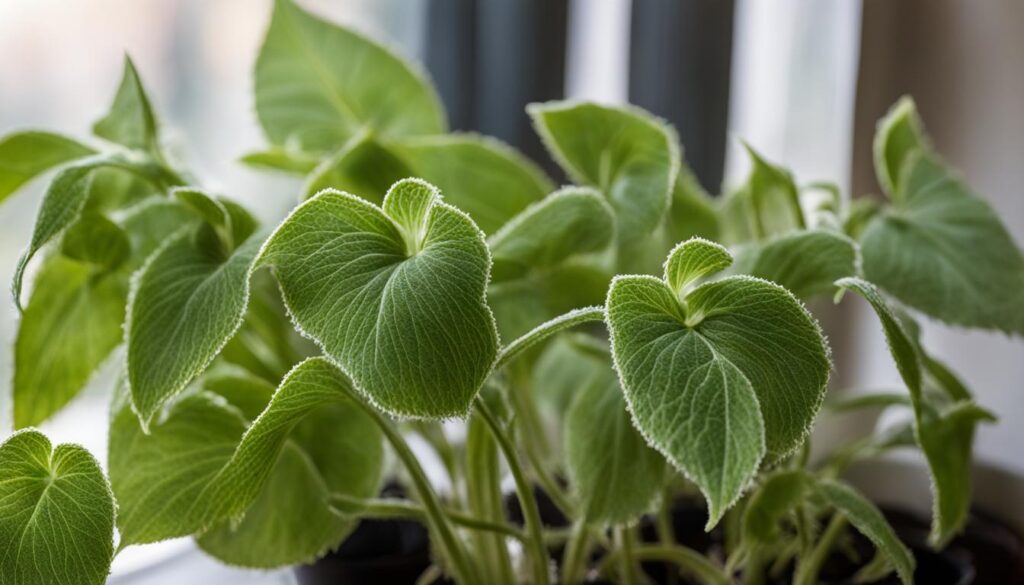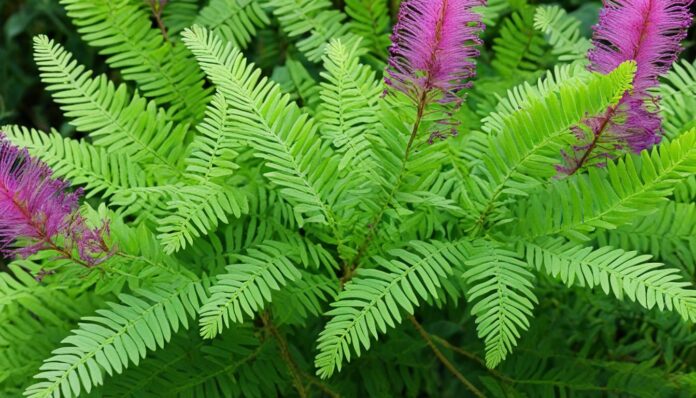The sensitive plant, scientifically known as Mimosa pudica, is a unique and fascinating addition to any indoor jungle. This touch-sensitive botanical has the ability to close its leaves at the slightest touch, making it a captivating and interactive plant for gardening enthusiasts. With its delicate foliage and beautiful pink flowers, the sensitive plant adds a touch of curiosity and elegance to any indoor space. Let’s explore the characteristics and growing tips for this one-of-a-kind plant.
Key Takeaways:
- The sensitive plant, or Mimosa pudica, is a unique and touch-sensitive houseplant.
- Its ability to close its leaves at the slightest touch makes it captivating and interactive.
- Growing the sensitive plant indoors requires repotting, moderate watering, and avoiding direct sunlight.
- Pruning is easy and effective in promoting branching, and fertilizing can be done through regular repotting.
- The sensitive plant exhibits remarkable sensitivity in its leaf movement and orientation.
Now that we’ve introduced you to the fascinating world of the sensitive plant, let’s delve deeper into its characteristics and explore how you can successfully cultivate this unique flora in your own indoor jungle.
Characteristics of the Sensitive Plant
The sensitive plant, also known as Mimosa pudica, belongs to the Fabaceae family and is native to Brazil. It is a unique plant that exhibits fascinating characteristics and behaviors. Here are some key details about this intriguing species:
- Height: In its natural environment, the sensitive plant can reach a height of 1m. However, when cultivated indoors, it typically grows to about 5 to 20 cm.
- Flower Color: The plant produces beautiful pink flowers that add a delicate touch to its appearance.
- Growth: The sensitive plant exhibits medium growth, making it manageable for indoor cultivation.
One of the most captivating characteristics of the sensitive plant is its ability to fold its leaves back on themselves when touched or exposed to external stimuli like rain or wind. This unique behavior is known as thigmonasty and serves as a defense mechanism against predators. When the leaves fold, they create a dramatic closing effect, transforming the plant into a fascinating spectacle.
The sensitivity of the sensitive plant is truly remarkable, as it responds to touch and other stimuli by swiftly retracting its leaves. This intriguing behavior is what sets the sensitive plant apart from other flora, making it an interesting addition to any plant collection.
Growing Tips for the Sensitive Plant

When it comes to caring for the sensitive plant, there are a few important tips to keep in mind. Follow these guidelines to ensure your sensitive plant thrives and remains healthy:
Repotting
It is advisable to repot the sensitive plant annually or when it outgrows its current pot. Choose a slightly larger pot with adequate drainage holes to prevent waterlogging. Opt for well-draining soil to ensure proper root aeration and prevent root rot.
Watering
The sensitive plant requires moderate watering. Maintain evenly moist soil by watering the plant when the top inch of the soil feels dry. Avoid overwatering, as it can lead to root rot. Allow the substrate to dry out slightly between waterings to strike a balance between moisture and dryness.
Indoor Planting
When planting the sensitive plant indoors, select a warm and bright spot that receives indirect sunlight. Avoid placing it in direct sunlight, as excessive heat can damage the plant. A temperature range of 60-75°F (15-24°C) is ideal for its growth and development. Consider using a humidifier to provide the necessary moisture, especially during dry winter months.
Outdoor Planting
While the sensitive plant can be grown outdoors, it is important to note that it thrives in limited parts of Southern Europe due to its lack of frost and cold resistance. Ensure the planting location receives ample sunlight and protection from strong winds. Avoid planting it in regions with freezing temperatures to prevent damage to the plant.
Follow these growing tips to create a conducive environment for your sensitive plant to flourish. With proper care and attention, you can enjoy the unique beauty and intriguing movements of this remarkable botanical.
Pruning and Fertilizing the Sensitive Plant
Proper pruning and fertilizing are essential for maintaining the health and vitality of the sensitive plant. By following these guidelines, you can promote branching, ensure proper nutrition, and protect your plant from pest attacks.
Pruning
Pruning the sensitive plant is a simple yet effective way to stimulate growth and encourage a bushier appearance. To prune your plant, gently remove any dead or wilted leaves using a clean pair of pruning shears or scissors. Additionally, you can trim back the tips of the stems to promote branching. Remember to sanitize your tools before and after each use to minimize the risk of disease transmission.
Fertilizing
Unlike some houseplants, the sensitive plant does not require regular applications of chemical fertilizers. Instead, it thrives when fertilized through regular repotting. When repotting your plant, use a nutrient-rich potting mix that provides the necessary minerals and organic matter for healthy growth. This method ensures a slow release of nutrients over time, reducing the risk of fertilizer burn and nutrient imbalances.
Dealing with Pest Attacks
While the sensitive plant is generally resilient to pests, it can occasionally fall victim to insects like aphids, whiteflies, or spider mites. If you notice signs of a pest attack, it is crucial to take immediate action to prevent further damage. Begin by manually removing any visible pests, gently wiping the leaves with a damp cloth or using a soft brush to dislodge them. To eliminate any remaining eggs or larvae, give your plant a thorough shower with room-temperature water, ensuring to wash both the upper and lower surfaces of the leaves.
To control pests, you can also make a natural insecticidal soap spray using liquid black soap diluted in water. Apply this solution to the affected areas of the plant, focusing on the underside of the leaves where pests often hide. Repeat these treatments every few days until the pests are effectively eliminated. Regular inspection and prompt action are key to preventing severe infestations and preserving the vigor of your sensitive plant.
The Sensitivity of the Sensitive Plant
The sensitivity of the sensitive plant is truly remarkable. Its leaves not only close when touched, but they also exhibit nyctinastic movement, which means they undergo changes in leaf orientation depending on light conditions. This movement, known as seismonastic movement, is believed to be a defense mechanism against predators and helps protect the plant from excessive water loss.
The main structure responsible for this movement is the pulvinus, which regulates the turgor pressure in the leaves.
| Plant Movement | Leaf Orientation | Touch Sensitivity | Seismonastic Movements |
|---|---|---|---|
| Closes when touched | Changes based on light conditions | Defends against predators | Protects against water loss |
As displayed above, the sensitive plant showcases various types of movements and adaptations in response to its environment. These unique features and behaviors make it a fascinating plant to observe and study. The ability to react to touch and adjust leaf orientation sets the sensitive plant apart from other houseplants, adding to its appeal for plant enthusiasts.
Distribution and Impact of the Sensitive Plant
The sensitive plant, scientifically known as Mimosa pudica, originated in the Caribbean and South and Central America. However, it has spread to various regions worldwide and is now classified as a pantropical weed. In some areas, the sensitive plant is considered an invasive species, posing a threat to native plants and ecosystems. Its fast growth and prolific seed production contribute to its ability to colonize new areas and outcompete other vegetation.
One of the major concerns associated with the invasive nature of the sensitive plant is its impact on agricultural crops, particularly in tropical regions. The plant can rapidly invade and dominate agricultural fields, reducing crop yields and causing economic losses for farmers. Its ability to form dense mats and outcompete desired crops for resources, such as water, light, and nutrients, makes it challenging to control and eradicate from agricultural areas.
Despite its negative effects, the sensitive plant also has some beneficial properties. It possesses a unique capability called phytoremediation, which allows it to extract and accumulate pollutants from soil. This attribute makes the plant useful in contaminated areas where it can help cleanse the soil of contaminants and improve environmental conditions. Furthermore, the sensitive plant forms root nodules that house nitrogen-fixing bacteria, contributing to the overall health and fertility of the soil.
In summary, the sensitive plant, or Mimosa pudica, has a wide distribution across the globe and is considered an invasive species in some regions. It can negatively impact agricultural crops, leading to reduced yields and economic losses for farmers. However, the plant also possesses beneficial properties, such as phytoremediation and nitrogen fixation, which make it valuable for improving soil conditions. Understanding the distribution and impact of the sensitive plant is crucial for effectively managing its presence and mitigating its potential detrimental effects on both natural and agricultural environments.
FAQ
What is the scientific name of the sensitive plant?
The scientific name of the sensitive plant is Mimosa pudica.
What family does the sensitive plant belong to?
The sensitive plant belongs to the Fabaceae family.
How tall does the sensitive plant grow indoors?
When grown indoors, the sensitive plant typically grows to about 5 to 20 cm in height.
What color are the flowers of the sensitive plant?
The sensitive plant has pink flowers.
How does the sensitive plant behave when touched?
The sensitive plant has the ability to close its leaves when touched or exposed to external stimuli.
What is the recommended watering routine for the sensitive plant?
The sensitive plant requires moderate watering, allowing the substrate to dry out between waterings.
Where is the best spot to place the sensitive plant indoors?
For indoor planting, it is best to place the sensitive plant in a warm and bright spot, avoiding direct sunlight.
Can the sensitive plant be planted outdoors?
The sensitive plant should only be planted outdoors in limited parts of Southern Europe due to its lack of frost and cold resistance.
How should I prune the sensitive plant?
Pruning the sensitive plant is easy and promotes branching.
How should I fertilize the sensitive plant?
Fertilizing should be done through regular repotting instead of adding chemical fertilizers.
What should I do if the sensitive plant is attacked by pests?
In case of a pest attack, it is best to manually remove the pests and shower the plant with water to eliminate any eggs. Liquid black soap diluted in water can also be sprayed on the plant to control pests.
What is the seismonastic movement of the sensitive plant?
The seismonastic movement refers to the changes in leaf orientation of the sensitive plant depending on light conditions. It is believed to be a defense mechanism against predators and helps protect the plant from excessive water loss.
Where is the sensitive plant native to?
The sensitive plant is native to the Caribbean and South and Central America.
Is the sensitive plant an invasive species?
The sensitive plant has become a pantropical weed and is considered an invasive species in some areas.
What impact does the sensitive plant have on agriculture?
The sensitive plant can have an impact on agricultural crops, particularly in tropical regions.
Does the sensitive plant have any beneficial properties?
Yes, the sensitive plant has beneficial properties such as phytoremediation, the ability to extract and accumulate pollutants from soil. It also forms root nodules that house nitrogen-fixing bacteria, contributing to soil health and nutrient availability.

